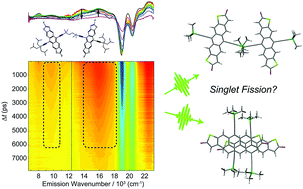Photophysical characterization and time-resolved spectroscopy of a anthradithiophene dimer: exploring the role of conformation in singlet fission†
Abstract
Quantitative singlet fission has been observed for a variety of acene derivatives such as tetracene and pentacene, and efforts to extend the library of singlet fission compounds is of current interest. Preliminary calculations suggest anthradithiophenes exhibit significant exothermicity between the first optically-allowed singlet state, S1, and 2 × T1 with an energy difference of >5000 cm−1. Given the fulfillment of this ingredient for singlet fission, here we investigate the singlet fission capability of a difluorinated anthradithiophene dimer (2ADT) covalently linked by a (dimethylsilyl)ethane bridge and derivatized by triisobutylsilylethynyl (TIBS) groups. Photophysical characterization of 2ADT and the single functionalized ADT monomer were carried out in toluene and acetone solution via absorption and fluorescence spectroscopy, and their photo-initiated dynamics were investigated with time-resolved fluorescence (TRF) and transient absorption (TA) spectroscopy. In accordance with computational predictions, two conformers of 2ADT were observed via fluorescence spectroscopy and were assigned to structures with the ADT cores trans or cis to one another about the covalent bridge. The two conformers exhibited markedly different excited state deactivation mechanisms, with the minor trans population being representative of the ADT monomer showing primarily radiative decay, while the dominant cis population underwent relaxation into an excimer geometry before internally converting to the ground state. The excimer formation kinetics were found to be solvent dependent, yielding time constants of ∼1.75 ns in toluene, and ∼600 ps in acetone. While the difference in rates elicits a role for the solvent in stabilizing the excimer structure, the rate is still decidedly long compared to most singlet fission rates of analogous dimers, suggesting that the excimer is neither a kinetic nor a thermodynamic trap, yet singlet fission was still not observed. The result highlights the sensitivity of the electronic coupling element between the singlet and correlated triplet pair states, to the dimer conformation in dictating singlet fission efficiency even when the energetic requirements are met.



 Please wait while we load your content...
Please wait while we load your content...